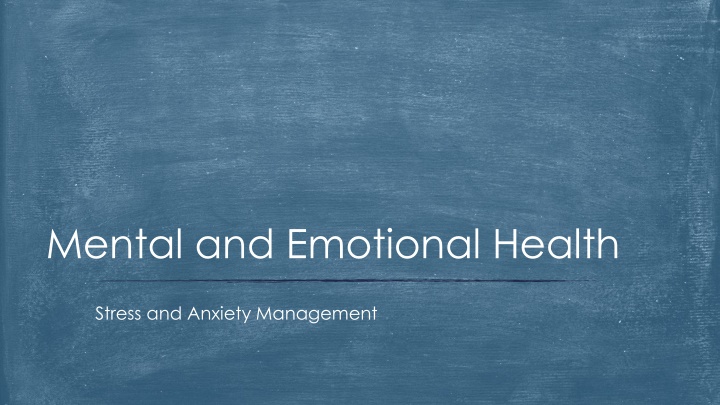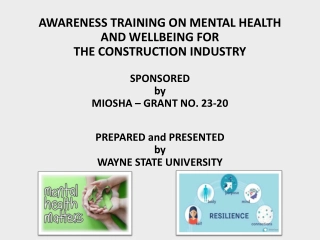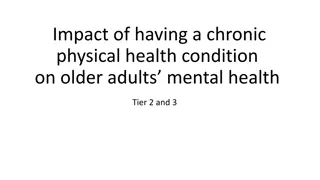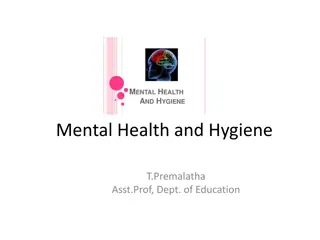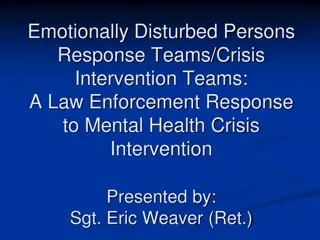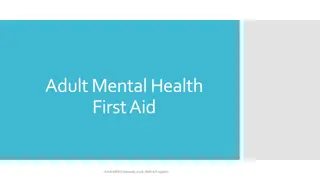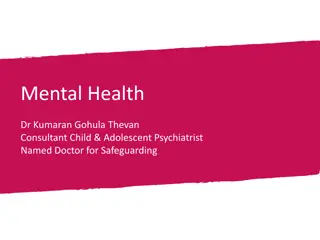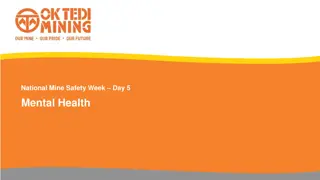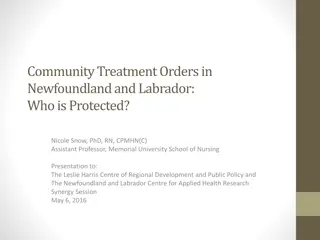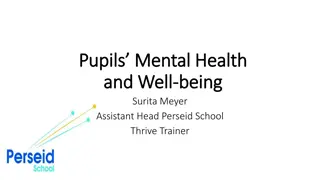Mental and Emotional Health
Traits of good character, ways to improve self-esteem, and defense mechanisms. Understand the importance of positive identity and needs for mental and emotional well-being. Discover strategies for stress and anxiety management.
Uploaded on Feb 23, 2025 | 1 Views
Download Presentation

Please find below an Image/Link to download the presentation.
The content on the website is provided AS IS for your information and personal use only. It may not be sold, licensed, or shared on other websites without obtaining consent from the author.If you encounter any issues during the download, it is possible that the publisher has removed the file from their server.
You are allowed to download the files provided on this website for personal or commercial use, subject to the condition that they are used lawfully. All files are the property of their respective owners.
The content on the website is provided AS IS for your information and personal use only. It may not be sold, licensed, or shared on other websites without obtaining consent from the author.
E N D
Presentation Transcript
Mental and Emotional Health Stress and Anxiety Management
Character Let s brainstorm: What are the six traits of good character? Fair Respectful Responsible Trustworthy Citizenship Caring Write each of these in their own circle and give an example of how you could demonstrate each one
The base of the pyramid represents our fundamental needs as we go higher we get to the needs that make us more mentally and emotionally healthy Despicable Me
Characteristics of good mental and emotional health Sense of belonging Sense of purpose Positive outlook Self-sufficiency Healthy self-esteem
Ways to improve your self-esteem Find friends who value and respect you Focus on the positives Replace negative self-talk with positive (compliment yourself) Mistakes are just learning opportunities don t harp on them Try new activities Exercise creates endorphins! Happy people just don't shoot their husbands Make realistic goals for yourself
Creating a positive identity Recognize your strengths and weaknesses Surround yourself with positive, supportive people Find a hobby or something that you love to do and do it frequently Stop making life a contest Help someone else Pep Talk
Defense Mechanisms Repression: Involuntarily pushing unpleasant feelings out of your mind Regression: Returning to behaviors characteristic of a younger age Denial: Unconscious lack of recognition of something that is obvious to others Projection: Attributing your own feelings or faults to another person or group Suppression: Consciously and intentionally pushing unpleasant thoughts out of your mind Rationalization: Making excuses to explain a situation or behavior rather than taking responsibility Rationalization example Compensation: Making up for weaknesses and mistakes through gift-giving or extreme efforts Defense Mechanisms examples
Managing Anger Do something to relax Channel your energy in a different direction Talk with someone you trust
Stressors: Anything that causes stress Life Situation -School -Bullying/friends -Peer pressure -Family problems -Moving/ changing schools -Breakups Environmental -Unsafe neighborhood -Media -Natural disasters -Terrorist attacks -War Biological -Changes in your body -Illness -Injury -Disability Cognitive -Poor self-esteem -Personal appearance -Not fitting in Personal Behavior -Busy schedule -Relationship issues -Smoking -Alcohol/other drugs Stress Contributors
Your Bodys Response to Stressors Stage 1: Alarm Physical Responses Anger Management Dilated pupils Increased sweating Increased heart rate Increased blood pressure Increased muscle tension Increased blood flow to the brain Increased respiration rate Stage 2: Resistance Stage 3: Fatigue
Psychosomatic Responses Headache Weakened immune system Increased blood pressure Digestive disorders Clenching your jaw or grinding teeth
The Grieving Process Denial or Numbness: difficult to believe or accept that the loss has occurred Emotional Release: the loss is recognized and often involves periods of crying Anger: the person feels powerless or unfairly deprived so they act out with anger Bargaining: the person promises to change if what was lost can be returned Depression: beyond the feelings of sadness feeling isolation and alienation Remorse: the person becomes preoccupied with thoughts of how the loss could have been prevented Acceptance: face the reality of the loss and experience closure Hope: remembering becomes less painful and the person begins to look to the future
Stress and Anxiety Management Refusal Skills: be able to say no to things that may bring you too much stress Plan Ahead: manage your time wisely so that you are not trying to complete several tasks at the last minute Think Positively: always think of the glass half full shift your perception Avoid Tobacco, alcohol and other drugs: costs a lot of money, creates health problems, and can bring on even bigger stressors Practice Relaxation Techniques: deep breathing, drawing, stretching/yoga, laughing, take a warm bath Redirect your Energy: use nervous or intense energy in a constructive way Seek Support: talking to someone usually makes you feel better Stay Healthy: get enough sleep, exercise and eat nutritious foods
Anxiety Anxiety is a feeling of uneasiness or worrying about what may happen. Occasional anxiety is natural. Brief feelings of worry, insecurity, fear, self- consciousness, or even panic are common responses to stress. Usually the anxiety goes away when the stressful event ends. A prolonged feeling of helplessness, hopelessness, and sadness is known as depression. Sadness effects everyone, but depression usually lasts longer and may produce symptoms that do not go away over time. It is one of the most common mental health concerns among teens. Some warning signs of depression include: Lack of interest in activities that once were enjoyed Lack of sleep or over sleeping Loss of energy Difficulty concentrating Sad or irritable mood
As teens reach puberty, body changes and media changes may cause some teens to put pressure on themselves to look a certain way which may lead to an eating disorder. On the other hand, a mood disorder deals with extreme highs and lows and changes in moods. This could include depression and bipolar disorder. Schizophrenia is a mental disorder in which a person becomes delusional and loses contact with reality. A conduct disorder includes stealing, cruelty, lying, aggression, violence, and vandalism. Teens who have a personality disorder are unable to regulate their emotions.
